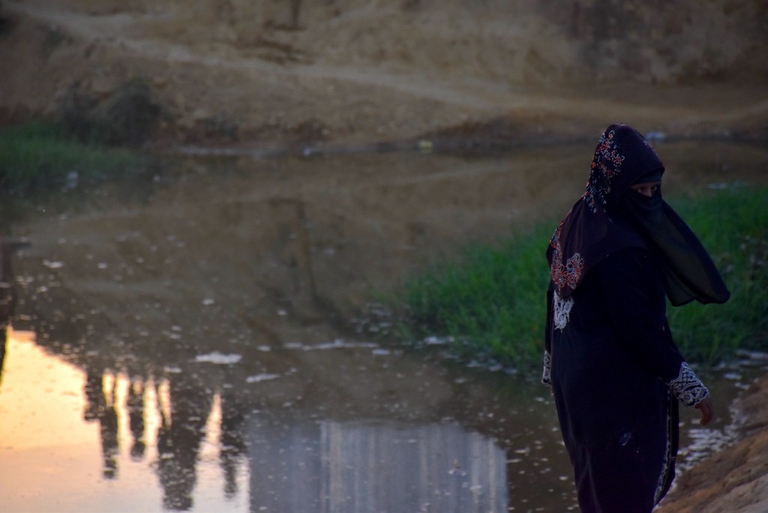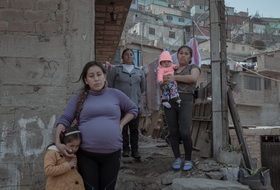
One in three women have suffered physical or sexual violence. With contributions from Europe, Africa, Asia and Latin America, we look at how this shadow pandemic affects every corner of the world.
Rohingya women who have escaped from Myanmar are forced to live in brutal conditions and are victims of unspeakable violence. Someone who visited the refugee camps in Bangladesh told us about what they saw there.
Cox’s Bazar, Bangladesh. Fatima is 15 years old, she has dark eyes and wears a pink veil that partly covers her long black hair. “It was morning and I was praying with my sister. They came in, beat us, undressed us and raped us. I don’t know how many they were, maybe ten”. On the 10th of August approximately one hundred Burmese nationalists and soldiers attacked Kyet Yoe Pyin, a small village in the state of Rakhine. “We screamed and cried. When the soldiers left us we hugged each other. Our neighbours put our clothes back on”.
Fatima’s parents were killed during the attack. A light shade embraces the tent in the Kutupalong refugee camp where the girl lives now. Her one-year-old nephew sleeps peacefully on a towel on the floor, in the meantime water for tea is being heated on a burner. “I arrived here on the 1st of September. After walking for three days through the forest we reached the Naf river and entered Bangladesh”: the 15-year-old left Myanmar to reach the refugee camps in the Cox’s Bazar district, 400 kilometres southeast of Dhaka, like another 600,000 Rohingya refugees have done since October 2016.
Kutupalong is a huge tent city that counts more than 500,000 inhabitants if summed to the residents of the Balukhali camp. The encampment has slowly engulfed increasingly large sections of forest due to the demand for construction materials and space. The numbers in this tragedy are uncertain. According to the United Nations Refugee Agency, the UNHCR, the official number of refugees who have arrived in Bangladesh since October 2016 is slightly over 600,000 but unofficial sources put this number close to 1 million.
Miriam is 14 years old, she comes from Hainda Par village. “They kept us in a large room for five days. We were 40 women. They came into the room and raped us. They used us until there was nothing left”. The girl was picked up after one of the many attacks on her village. “My parents were home when they attacked us. They shot a missile, my dad and mum never came out of the house”. Miriam wandered the forest for two days before returning to Hainda Par. She was picked up by the few inhabitants that were still left there. Now she lives in Kutupalong with her former neighbours.
Read more: Zaatari refugee camp, where 80,000 Syrians yearn to go back home
The streets of the Rohingya refugee camps in Bangladesh all look the same. They’re narrow, dusty and muddy, they climb up 30 metres before diving into small valleys where polluted and foul-smelling waters meet. Assima is 20 years old and her tent is on a hill covered by trees that haven’t been used as construction materials. Four children play outside the tent with a plastic bottle tied to a string. A woman goes to one of the water pumps that were installed by the government and NGOs to distribute clean water.
“We arrived on the 29th of August, Tula Tuli was our village,” Assima crawls into a ball in a corner of the tent. “It’s wasn’t the first time we were attacked by the military”. The area she comes from is one of the most frequently attacked by soldiers and nationalists. “We heard gunfire and screams, so we went outside and saw what was happening – her brother lowers his gaze as tears fill Assima’s eyes –, they shot people and threw them in the canals that surrounded the village. They killed a child that was four months old and threw him in a hole. The mother dove into the bodies to get him back, so they killed her too”.
The women were captured by soldiers and transported to a house close to the village: “We were beaten and raped in groups of four or five”. After she was freed, Assima was reunited with her brother, she gathered what she had left and walked for three days to reach the border with Bangladesh.
Su Faira is 20 years old too. She tells us her story, wearing a black niqab that reveals only her eyes. “My husband was arrested four years ago. On the morning of the 24th of August some soldiers showed up at the village and told me they would take me to him and give him back,” but they weren’t reunited at the end of her journey and Su Faira was taken to the forest. “We were four women, they made us come out from the truck and raped us for hours – the girl has no news of her husband, she doesn’t even know if he’s alive or dead – then they released me. I was broken. After walking for a whole day I returned to my four-year-old daughter and parents”. The Rohingya refugee now lives in a tent in Kutupalong. “We share the tent with another family. We’re here now, but my daughter needs medicine and food.”
Arafa lives a few hundred metres away from Su Faira and her daughter. After having passed a rice field and a canal that has become an open sewer, the 15-year-old girl waits for her guests at the entrance to her “home”. “They came to the village at the end of August, I can’t remember the date – Arafa is scared, she’s still in shock –. They burned our homes so we ran away. It was very chaotic. I can’t remember”. The Rohingya refugee was kept in a cell for two days, she was abused and raped by Burmese soldiers. When she returned to Pook Kul village she found her parents. Now she lives with them.
“We offer them assistance from doctors and psychologists for their recovery, but it isn’t enough, there are are a lot of cases and we must defeat the shame victims feel,” explains Doctor Mahdi, director of field operations for the Health Management BD Foundation, an NGO that offers refuge to abused Rohingya women. “We operate in Balukhali, 50,000 people, but only in our area, which is one third of the camp we assist around 200 cases”.
Read more: South Sudan, these photos capture the strength of women refugees
Zaida waits for us in the madrasa, the Islamic school that was set up near the entrance of the Kutupalong refugee camp. “They killed my son and burned his body in front of me,” the 21-year-old refugee now lives with her six-year-old daughter in a tent close by. “They captured me two days later”. Zaida escaped from Saiman Par after the first attack and was captured in another village where she’d found refuge. The army transported her to a centre she can’t name or locate.
“I spent two days in a house,” the girl doesn’t talk about rape explicitly, she uses the term “incident” to describe what was done to her. “When they released me I took my daughter and walked to the Naf river”. After she waited for a day on the Burmese beach, the woman found a boat that would take her to the other side of the river, “but the owner ran away and stole the few things we had brought with us, leaving us at the mercy of the currents for five or six hours”.
At half past four in the afternoon a red sun starts to set in Kutupalong. The traffic close to the refugee camp thickens. We can’t stay after five. Volunteers and NGO workers exit Kutupalong, leaving the inhabitants on their own. Alone with their stories and the ghosts of their past.
Siamo anche su WhatsApp. Segui il canale ufficiale LifeGate per restare aggiornata, aggiornato sulle ultime notizie e sulle nostre attività.
![]()
Quest'opera è distribuita con Licenza Creative Commons Attribuzione - Non commerciale - Non opere derivate 4.0 Internazionale.
One in three women have suffered physical or sexual violence. With contributions from Europe, Africa, Asia and Latin America, we look at how this shadow pandemic affects every corner of the world.
The Istanbul Convention against gender-based and domestic violence marks its tenth anniversary. We look at what it is, who its signatories are, and what the future might hold.
European Commission President Ursula von der Leyen reminded us of the gravity of violence against women around the world, and of the Istanbul Convention’s utmost importance.
President Erdoğan has pulled Turkey out of the Istanbul Convention, key in the fight against gender violence, claiming that it favours the LGBT community rather than family values.
Violence against women in Peru has increased as a result of Covid-19 lockdowns. 14,912 people were reported missing from January to November 2020, more than half of them minors and 64 per cent women. People have been confined to their homes for months, many forced to endure poor physical, economic and social conditions. A situation that
Joys Estefani Qqueccaño Huamani, 24, disappeared from her rural community in Peru on 9 October. Her family began looking for her independently of the authorities and despite the resistance of relatives of Joys Estefani’s ex-partner Arturo Ccana Condori, 32, charged with committing violence against her on 28 September, eleven days before Joys Estefani disappeared. Photos
Costa Rica celebrated its first same-sex marriage when two women, Alexandra Quiros and Dunia Araya, celebrated their wedding: an “extraordinary moment”.
The pandemic and its restrictions are affecting everyone, without exceptions. However factors like housing, income inequalities, gender, access to technology and working conditions are influencing how people experience the health crisis.
Time magazine’s 100 Women of the Year project sheds light on influential women’s stories, from Amelia Earhart to Greta Thunberg. A selection of some of the greats for International Women’s Day.









